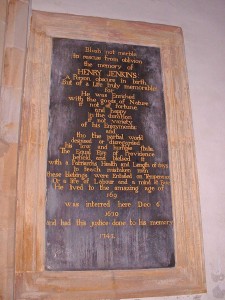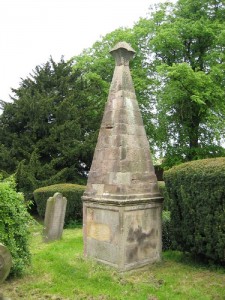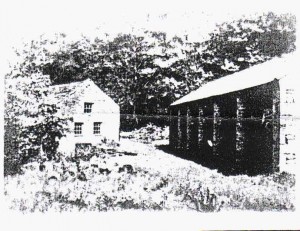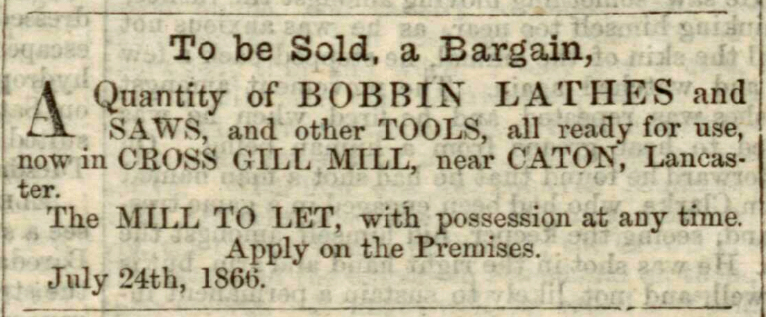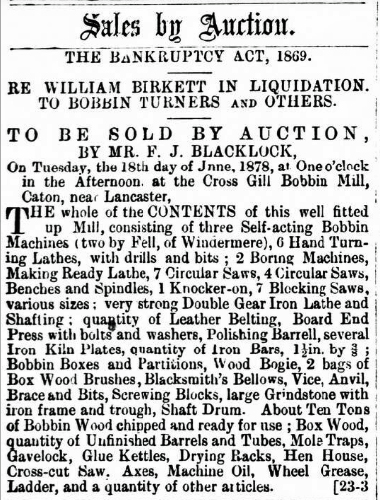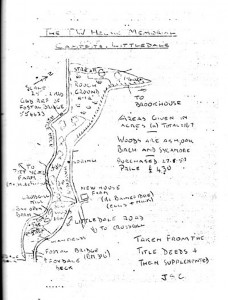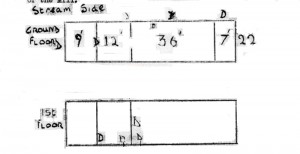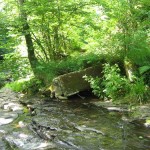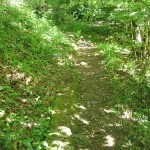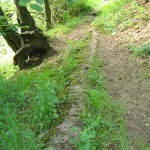CROSSGILL MILL, LITTLEDALE
From “Caton – Past & Present” published 1979: “Prior to 1780, Cross Ghyll Littledale was a corn mill and later manufactured bobbins.”
Hennets Map of Lancashire 1829 shows Crossgill Mill north of Pot Yate.
The 1st edition Ordnance Survey 1847 has Crossgill Mill (Bobbin) shown, north of a mill race, with a weir across Artle Beck feeding into this.
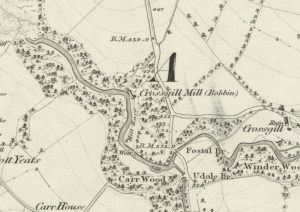
There is more detail on the 1910 OS 25-inch map showing the mill, wood shed and race. The plantation in field number 585 is not there at this point.
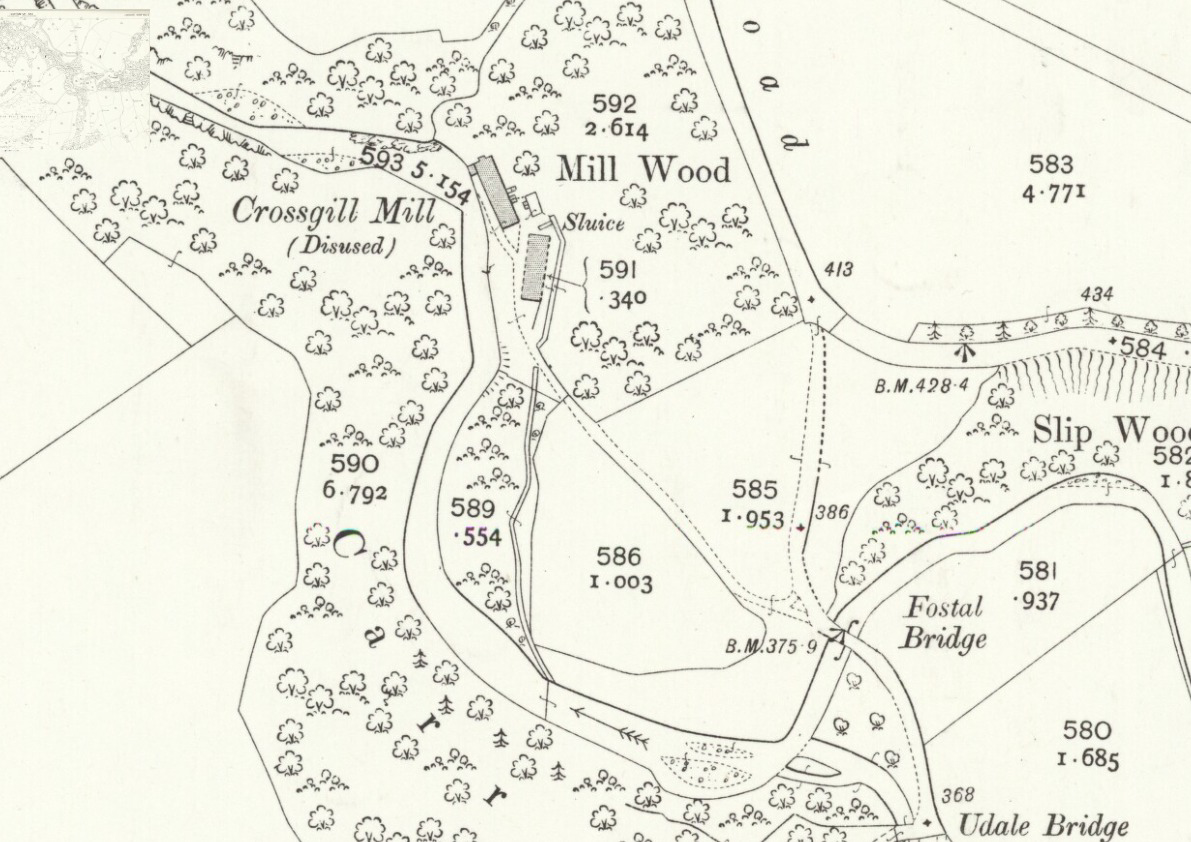
Click here to see an article on the mill (source to be confirmed).
And here to see a photo of a similar timber shed to that at Littledale at Stott Park Bobbin Mill at Finsthwaite.
Kendal Mercury 11 January 1851:
CROSSGILL, NEAR CATON.– The worthy proprietor of the Crossgill Bobbin Mill, Mr. Jonathan Walling regaled the workmen in his employ with an excellent dinner on New-Year’s-Day. In the evening, the wives and sweethearts of the men took tea at Mr. W’s hospitable table.
The remainder of the day was diverted by dancing to the strains of Mr. Newton’s quadrille band, and by the performance of a party of vocalists from Lancaster, who entertained the company with various songs, trios, duets and and glees.
Census 1841 (findmypast):
Township of Caton
Crossgill Mill
Johnathan Walling 35 Bobbin Maker, Nancy Do 29, Agnes Do 3, Richard Do 2, Agnes Do 80
Thomas Palmer 19 Bobbin Maker Ap
Richard Tindall 19 Bobbin Maker Ap
George Tindall 18 Bobbin Maker Ap
Thos Titterington 17 Bobbin Maker Ap
Rhd Parkinson 14 Bobbin Maker Ap
Thomas Clark 19 Bobbin Maker Ap
Samuel Cokell 15 Bobbin Maker Ap
Can House
Thos Mackereth 54 Bobbin Maker, Ann Do 63
Robt Thompson 30 Bobbin Maker, Ann Do 30, John Do 10
Joseph Johnson 20 Bobbin Maker
John Taylor 25
Catherine Do 25
Thos Bowker 70 Ag Lab
John Hewertson 20 Bobbin Turner
Thomas Taylor 10
Census 1851: (findmypast)
Township of Caton and Littledale, Village of Littledale
12. Crossgill
Jonathan Walling Head Mar 44 Bobbin Manufacturer born Staveley, Westmorland
Nancy Do Wife Mar 39 born Kendal, Westmorland
Agness Do Daur U 13 born Caton, Lancs
Riichard Do Son U 11 born Caton, Lancs
John Do Son U 9 born Caton, Lancs
Jonathan Do Son U 6 born Caton, Lancs
Elizabeth Do Daur U 4 born Caton, Lancs
Ellenor Do Daur U 2 born Caton, Lancs
David Harrison Serv 39 General Servant born Askham, Westmorland
John Hodgson Shopman 39 Shopman born Tatham, Lancs
plus 8 apprentices, a servant and a sawyer
Westmorland Gazette 04 August 1866:
The Lancaster Gazette of December 8th 1866 has the following interesting article giving an insight into the workings of the mill:
FATAL ACCIDENT AT A BOBBIN MILL IN LITTLEDALE
On Wednesday morning last, an accident of a most shocking nature happened at the Cross Gill Mill, in Littledale, to a young man named Robert Savage, who for many years has carried on the business of a bobbin turner at that place. It will be necessary to state that about three months ago, Mr William Hodgson came into possession of the mill, which is a two-storey building, and since that time he has used the upper room for bobbin turning, whilst the lower room, where the accident occurred, has been devoted by deceased’s father to the repairing of machinery. Across the room a shaft is suspended, to which pulleys and belts are attached for the purpose of turning by water power a large grindstone, and machinery used in the trade. It seems that about eight weeks since deceased came over from Preston, at his father’s request, to assist him in finishing some work, and (to use Mr Savage’s own words) in “squaring up matters,” prior to his quitting the premises. Shortly after eight on Wednesday morning, deceased went to the grindstone to sharpen a hammer, and it is supposed that whilst this operation was going on, the band by which the stone was turned slipped off the pulley. Deceased, in endeavouring to put it on again, had to lean over a counter shaft, twelve inches in length, the end of which was jagged, owing to a piece having been broken off some time ago. In about five minutes after deceased had been seen to enter the lower room a sudden noise as of the breaking of machinery was heard. Mr Hodgson ran down the steps leading to the room, and was horrified to find the deceased suspended from the counter shaft, and being carried round it. He shouted to the men working on the premises, “Robert’s killed! Stop the water.” This, however, was being already done, but as the shaft was revolving at the rate of something like 60 times per minute, it had accomplished its fatal work before any assistance could be rendered. Deceased’s jacket, waistcoat, neckerchief, &c, were completely torn off his body in long shreds, which, together with his watch, were found tightly wrapped around the shaft. The body presented an awful spectacle . . . whilst the legs and arms were fearfully bruised. The unfortunate deceased, who was 30 years of age, was removed to his father’s house, a short distance from the mill, to await an inquest. He leaves a widow and five children, all of whom were at Preston at the time of the accident, to lament his untimely end. He was a very steady young man, and some time ago was in the employ of the Lancaster and Carlisle Railway Company.
The inquest upon the body of the deceased was held at Littledale, on Thursday afternoon, before Mr Holden, coroner. The following evidence was given:-
William Hodgson, said: I am the tenant of Cross Gill Mill, in Littledale. It is a bobbin mill, and I am a bobbin turner. I have been in possession for about twelve weeks, and succeeded Mr Savage, the father of the deceased. I found the deceased working there when I came to it. His duties were to assist his father in repairing machinery. He was not in my employ. I last saw him alive yesterday morning, a few minutes before eight o’clock. I merely saw him go past the mill door alone. In about five minutes afterwards, I heard a noise like the breaking of machinery. I went down one of the steps leading into the lower shop, and I saw the deceased hanging from the counter shaft by the arm. I exclaimed, “Robert’s killed; stop the water,” but the water had already been stopped by the men who had heard the noise. I sent for assistance, and in the meantime tried to prevent the wheel from going round. I saw he was dead, and he must have been killed instantaneously. He was alone in the lower shop at the time.
There was a hammer close beside him, and a mark on the grindstone showed that he had been sharpening it. The belt that turns the grindstone had run off the counter shaft.
The belt was in good repair, and the shaft was in running order to the best of my belief. The end of the shaft has been broken off, and at the present that end is rough and jagged. I was not aware before that it had been broken, but I knew it was rough, which I thought had been caused by hammering in fastening on the pulley.
The rough end of the shaft projects about 12 inches over the bearing, and that projection is quite unnecessary. This shaft has been put up for Mr Savage’s own private convenience, and it had no connection with the bobbin mill. That shop is in Mr Savage’s occupation.
Edward Park, bobbin turner, said: About five minutes to eight yesterday morning, I was with the deceased in the lower shop. I went out for about five minutes, leaving him guiding a hammer with his back to the window. I heard a noise, and shouted, “Stop the water, “ which was done immediately.
Richard Sharples 1, farmer: I reside close to the bobbin mill. Yesterday morning, about half-past eight, I heard of the accident, and went to the mill. The first man I saw was Robert Hodgson, who said, “Robert’s killed.” I went into the lower shop, and found deceased lying on his breast, over the shaft end. The shaft was still moving a little, and the body was drawn through. I got my knife out, and commenced to set him at liberty. His face was cut . . . His legs were very black, and he was bruised all over his body. I have no doubt that he must have been killed instantaneously.
John Savage 2 deposed: I reside in Littledale. The deceased was my son, who was 30 years of age. He has been living with me for the last eight or ten weeks, was assisting me in repairing various things, and getting things squared up ready for moving. I have occupied this mill, for the last 13 years. There was a piece of the shafting broken off about two years ago. The jagged end is still there. The reason that it was broken off was that it was not necessary. The projection was not at all required. I have put on the strap scores of times myself, and we never thought there was any danger attending it. Deceased was a skilled workman. The shaft is going to be removed.
The Coroner said he was glad to hear that, as he should have ordered its immediate removal.
This being the whole of the evidence.
The Coroner proceeded to sum up. After alluding to the exceedingly painful nature of the inquiry, he said, one lamented it the more, because, apparently the accident might absolutely have been avoided. On examining the place where it occurred, he had caused the clothes of the deceased to be taken off the shaft, which from its appearance, might almost be supposed to have been designed for catching clothes; and certainly, if it once caught hold of them, it would be beyond human power to extricate them. No doubt the deceased, whose end they must all deplore, was in the act of putting on the belt, and on leaning over the shaft, it caught his clothes, and in a moment fatal injuries were inflicted upon him. Such a projection should not have been allowed in a mill which was subject to authorised supervision, and it ought not to have been allowed here. It appeared that they had gone on working the shaft in that state, without apprehending any danger. The question the jury had to decide was, whether deceased came to his death by accident or otherwise. He was engaged in the shop by himself, and nobody was near him at the time of the accident. They could only say therefore, by their verdict that he was accidentally killed.
The Jury concurred in the Coroner’s observations, and returned a verdict accordingly.
It is worthy of mention that a fatal accident happened at the above mill, five years ago, when a lad was killed by a circular saw.
Notes:
1. Richard Sharples appears in the 1881 national census (14 years after these events) living at Cross House, Caton, then aged 51 and born at Slyne. He is a farmer of 66 acres. Living with his family are 4 boarders, aged between 22 and 38 years, three of whom are brothers, who are all shown as woodcutters.
Trees in the vicinity were obviously used to provide the raw material to make the wooden bobbins.
2 Kelly’s Post Office Directory of Lancashire 1858 includes an entry under Lancaster: Caton, as follows:-
John Savage spindle & fly maker & bobbin turner, Littledale
He is still there in 1864 – Trade Directory, Post Office Directory of Lancaster & its Vicinity
Bobbin Mfrs & Turners, and
Spindle & Fly Manufrs
Savage J, Littledale, Lancaster
The same directory in 1873 states:- Caton: Littledale – Here is a small bobbin mill. The neighbourhood abounds with suitable wood. Population 1871 = 104.
Also, Birkett & Piel, bobbin manufacturers, Littledale
Census 1861: (findmypast)
Township of Caton, Hamlet of Littledale
1. New House
John Savage Head Mar 51 Bobbin Manufr Agtl Impl maker Employing 4 men born Wyersdale, Lancs
Mary Savage Wife Mar 57 born Kirkham, Lancs
Joseph Savage Son Un 19 Practicle Engineer born Kirkham, Lancs
William Monks Apprentice Un 18 Apprentice bobbin Turner born Manchester, Lancs
Robert Beck Apprentice Un 17 Apprentice bobbin Turner born Lancaster, Lancs
William Johnson Servant Un 19 Unskilled Laborer born Leeds, Yorks
Isabella Whinray Servant Un 18 General Servant born Warton, Lancs
Lancaster Gazette 08 June 1878:
The Lancaster Guardian of March 30th 1895 also has another informative article
SAD DEATH OF A LITTLEDALE FARMER
A painful sensation was caused in Caton and district on Saturday when it became known that Mr W Huddleston1 of Guy House, Cross Gill, Littledale, had been found drowned in the Bobbin Mill dam, Artle Beck, the previous day. The deceased, who was 60 years of age, had during the past year had what may be termed “a run of bad luck”. In April he had one of his eyes knocked out by a cow, and since then he has had an attack of fever, one of his family has had her sight affected, and the deceased had also lost some valuable stock. These misfortunes are supposed to have preyed on his mind, and he has been in a desponding state for some time. The circumstances of the drowning pointed to suicide, the deceased having left his home early on Friday morning ostensibly to feed the cows. He did not return, and on a search being made by his daughter, his body was discovered in the mill weir.
The inquest was held on Saturday afternoon before Mr. Neville Holden (deputy coroner). The following evidence was given:-
Mary Ann Huddleston 2 said: I am a daughter of the deceased, William Huddleston 1. He lived at Cross Gill Farm, Littledale, near Caton. He was a farmer and was 60 years of age. About a year ago, in April 1894, he lost an eye through an accident. After that he was despondent, and then he had scarlet fever. He has never been well since. He has never said anything to me to lead me to think he intended to take his own life. Yesterday morning I saw him about 5-15. He was then in his usual health. He was lacing his shoe and did not say anything that I remember. He had his breakfast with the rest of the family. He sat silent most of the time, but that was nothing unusual.
He went out about 7-15, and he did not say where he was going, but I thought he would be going to feed the cows as usual. Shortly after nine o’clock, when I found he had not returned, I went to look for him. I first went to the Bobbin Mill close by, and then to the mill weir. I found his body lying in about 9ft of water. He was motionless and apparently quite dead. I went and called my brother, aged 14 years, and sent him to Pott Yeats for help. My cousin, William Huddleston, returned with him. I was there when they took his body out of the water. I saw his hat about a dozen yards away, and that was what led me to look into the water.
John Gorst 3 , Littledale, said: On Friday morning about seven o’clock I saw the deceased standing by his house. I said to him “ It’s a fine morning” and he replied “Yes, very”. We talked about the weather, and then I went on. I have known the deceased all my life. He has been very despondent lately, but I did not think him a likely man to take his own life.
William Huddleston 4, farmer, Pott Yeats, said: The deceased was my cousin. On Friday from what I heard I went to the mill weir and found the body of the deceased in the water. I took it out, and found that deceased had been dead some time. The body was cold and fully dressed except the head. There were no signs of struggling on the bank side.
P.C. Balshaw, stationed at Caton, said: I received information of the drowning case about ten o’clock on Friday morning and at once proceeded there. I found the body of the deceased on the bank by the mill weir. I have examined the body and the only mark is a slight cut on the head, probably caused in taking the body out. Deceased’s watch had stopped at 6.35.
The Jury returned an open verdict of “Found drowned”.
Notes:
1. William Huddleston (the deceased) appears in the 1881 census (14 years previously) living at Crossgill, Caton, then aged 46 and born at Littledale. He is a farmer of 139 acres living with his wife Ellen aged only 29 and born at Clapham. The couple have four children, 3 daughters including Mary Ann 2 (aged 6) and one son Joshua (aged 5 months). Also living in the property are 2 servants, one a farm servant (indoor) and the other a general servant.
3 John Gorst is in the same census living at Hawes House, Caton. He is then aged 14 and born at Littledale. His father, William Gorst, born at Barnacre, is a farmer of 150 acres.
4 William Huddleston also appears in 1881 living at Pottyeats, Caton. He is then aged 15, a farmer’s son, born at Littledale. He is one of 8 children of Henry and Mary Huddleston (nee Kelsall), both of whom were born at Quernmore. Henry is a farmer of 173 acres.
It appears from the above, therefore, that a mill existed on the site by Artle Beck for over 200 years. In the 18th century this began life as a corn mill but, following the coming of the industrial revolution * and its associated cotton mills it moved over to producing bobbins.
The relative position of the mill (now demolished) can be seen from a plan of the campsite, copied from “Scoutarian 1957 – 60” –
and to see the mill’s dimensions
The early maps indicate that water to power the mill was taken from Artle Beck from a weir constructed at a point between the flood plain and the lower field. Little evidence remains today of the original weir construction but the associated head race, in the form of a concrete channel can still be seen quite clearly leaving this area of the beck and heading almost due north directly towards the barn and former mill buildings. Prior to the creation of the present lower field camping area this channel could be seen at other points along its course.
(see photos – June 2004, © Alan Hague)
The late Norman Winder sent me a photo of the recently uncovered again bevel gear that used to lift the sluice on the millrace outlet.
The unfortunate William Huddleston, mentioned above, must have met his sad end in the pool behind this weir. It would be quite a small distance for him to walk from his house at Cross Gill along the old lane, which ran to the south of the present Littledale road, and down to the beck.
Imagine young Joshua, perhaps distraught, despatched to fetch his cousin from Pott Yeats, climbing breathlessly up the steep hill to the farm. It must have seemed like an eternity before he reached the farm and blurted out his tragic news.
(Lancashire County Council Environment Directorate – Heritage Website)
All the major settlements along the river Lune – Caton, Halton, Hornby and Wray were engaged in either textile spinning, for example cotton, silk, linen, woollens and flax, or they contained a significant number of weavers. The handloom industry provided an important source of income for much of this area.
One particular concentration of mills was located at Caton in the Lune Valley and the building of five mills at Caton Town End (Willow, Rumble Row, Low, Forge and Ball Lane) saw the settlement rapidly expand. Low Mill was originally an early Arkwright type mill but this was burnt down in a disastrous fire in 1837 and then rebuilt in the form that it appears today. It was built on the edge of the flood plain of the river Lune, while on a terrace above it a large mill pond covering 2.2 acres provided the water power. The mill initially produced low grade cotton yarn, and up until 1970 it was used to produce warp for weaving in Lancaster. It was recently converted into flats. Forge Mill, also located in Caton was used for spinning cotton, silk and flax and from 1869 to 1931 it was used to produce bobbins.
The Cragg
One other interesting historical snippet relates to The Cragg, or Crag House – the farm beyond Pott Yeats at the top of the hill on the Quernmore road.
This property has a long history and was reportedly granted by Sir Edward Stanley of Hornby Castle, 1st Lord Monteagle to Richard Baines, as a reward for valuable service as his standard bearer at the battle of Flodden Field in 1513. Hence, presumably, Baines Cragg nearby. Apparently a field on the farm was named in honour of Flodden and carried that name for many years.
Henry Jenkins 1501 – 1670
Another interesting connection with Flodden is that Henry Jenkins generally acknowledged as having been the oldest man in England, and buried in Bolton on Swale churchyard, born before there were any proper records and who died in 1670, from the account that he gave of his age at the date of that battle, made him 169 years of age!
